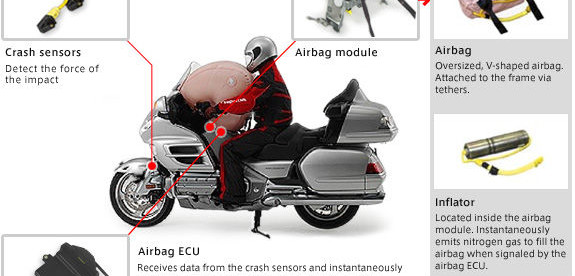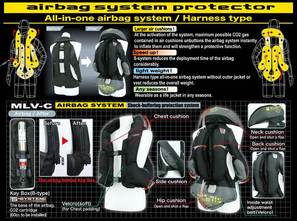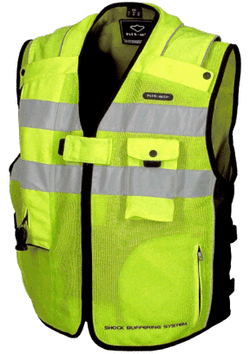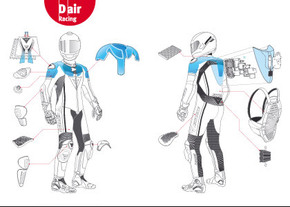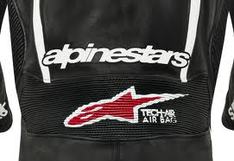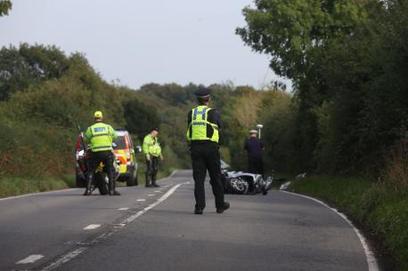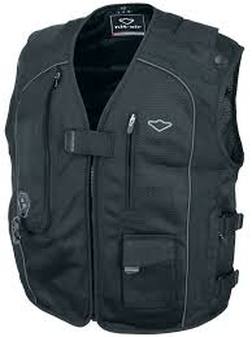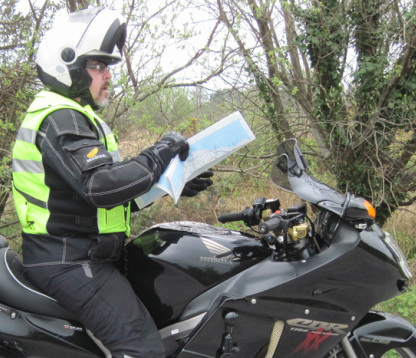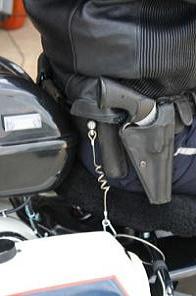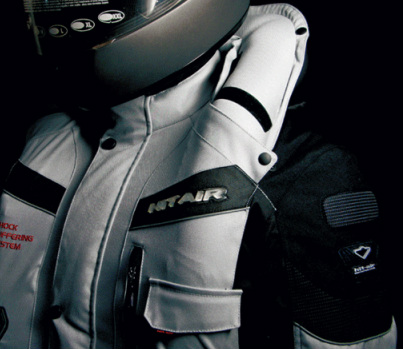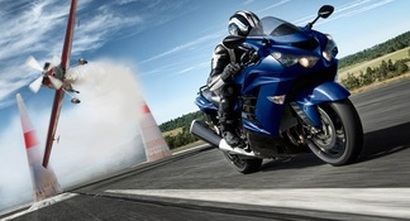Inflation Never Seemed So Good: Motorcycle Airbags Review
We’ve grown accustomed to airbags in cars; the first patents were taken out way back in the 1950s, with production models arriving twenty years later. NASA have used them on spacecraft, bags cushioning the landing of Luna 9 in 1966 and of Mars Pathfinder in 1997. Although a motorbike airbag jacket was actually a Hungarian invention, with a patent registered in 1976, it’s only recently that inflatable safety systems have begun to catch on for bikes and riders.
Conspicuous use in Moto GP has helped raise the profile of rider bags, with stars from Rossi through to Espargaro and Guy Martin now wearing air suits. They seem to work too; Marc Marquez crashed at 209.9 mph during practice at Mugello this year, but the airbag-clad Repsol Honda rider was miraculously cleared to ride right after the event, something Honda think would not have happened but for the suit.
The technology is trickling down to regular riders, albeit slowly – with Alpinestars, Dainese and Spidi among the mainstream high street kit suppliers with offerings on the market.
Technical complexity is cited as one reason why airbags are not more widespread in real-world biking, but it could just as easily be to do with the psychology of riders; bikers accept what they do is risky and may be less interested in the product to begin with.
Then again, that was the attitude to helmets too before they became compulsory in 1973; and the same issue occurred with car drivers and seat-belts. Given the power of the health and safety lobby, is it only a matter of time before all suits are made this way? There’s another more powerful argument; riders are getting older; a US JD Power survey in America showing that riders’ median age increased from 40 in 2001 to 49 in 2010. As we get older we tend to become more aware of our own fragility; widespread acceptance and use of airbags in motorcycling may be closer than you think.
Here we take a brief look at the technology, ask whether it works, and give some feedback from ordinary riders who use airbags every day. We ask if you should be interested, if you should buy into the idea, and always the bottom line, how value for money stacks up. We’ll be looking at both bags on bikes and bags worn by riders.
On-Bike Systems
On-bike systems are those integral to the bike. Honda were first on the market for the on-bike kind, bringing out a tank-mounted system in 2006 on their legendary Goldwing.
Not the first time it had been tried though – in the ’90’s the good old TRL (Transport Research Laboratory) fitted them to an old Norton Commando!
Honda’s system uses sensors on the front forks to detect impact and then activates the bag which is fired by a small pyrotechnic charge just as in a car. So far however it remains the only on-board system in mass production.
Lanyard Operated Jackets
The simplest kind of airbag is a neat slip-over vest that you wear over any bike jacket. This entry-level kit is operated by a lanyard or cable, attached to the bike. The rider clips this to the vest before setting off; if he or she falls, the lanyard pulls a mechanism that releases a pin, puncturing the metal cap of a CO2 cylinder. The jacket inflates in something like a quarter of a second.
This budget airbag is relatively cheap and has the advantage of being portable not only between bikes, but also between riders,
simply by swapping the outer vest.
Inside the fabric outer layer, a tube-like structure carries CO2 around the body, inflating and cushioning the neck, back, base of spine and chest, giving far more protection than a solid back protector. However, there is enough gas to make the suit almost rock hard and space for conventional body-armour too.
Entry Level
Simple vest protectors are easy to maintain. The fabric outer is removable for washing, and the CO2 cylinder can be replaced simply so that a jacket without major damage can be re-used. It’s a lightweight, adaptable system that requires no real tinkering with your bike and should offer surprisingly good all round protection.
However, for some, a fiddly wire dangling off the bike may be a turn off, and what about accidental deployment? Suddenly turning into the Michelin Man at traffic lights would NOT be cool, though it might give your mates a laugh.
In fact fears of accidental deployment are myth. The manufacturers have thought of the Michelin-Man thing and accidental deployment is actually very hard to bring about. The force involved in standing up and giving it an accidental tug is many times less than
the force of falling off and the system is calibrated accordingly.To Buy this product online on Amazon Click Here
Second Gen: Sensor Operated Suits
Image: Dainese, Click image to go to Dainese website
While Lanyard systems score on affordability (typically in the £250-500 range – similar to medium priced crash helmets) they suffer from two problems; deployment, though rapid, is slower than the best now achievable, while for some, the dangling wire makes the whole thing a tad cumbersome.
Enter the latest generation of airbag suits, typified by Dainese’s high-tech D-Air System.
D-Air uses a sophisticated set of sensors, including accelerometers, gyroscopes and a GPS, to determine accurately when the airbags needs to be deployed. Most of this gear is hard wired to the bike, thus freeing the rider from the need to lug it around.
The Dainese system uses cold gas generators – chemical packs that produce gas fast. You can also find these in airliners to make the oxygen needed if the face masks deploy. But, while the airline ones generate heat, these don’t. New technology means that this kit does its stuff fast but the gas is cool, which is, uh, cool. Full deployment is also faster than a ZX-14 up the drag strip – fully inflated in less than 30 milliseconds – literally faster than the blink of an eye. The D-Air Street range starts at about £600 for a vest type jacket plus £400 for the on-board electronics.To Buy this product online on Amazon Click Here
High Tech Suits for Scoots
Alpinestars also do high-tech outfits, with sensors and futuristic materials galore. But this level of cutting edge technology comes at a price.
If around a grand for the Dainese system sounds expensive, then the Alpinestars Tech Air Race suit, at £5,400 (yes you read it right), is enough to send your wallet whimpering for cover. On the other hand the quality is, of course, superb.
Alpinestars Tech-Air Race Suit
The Lottery Winners’ Suit of Choice?
No doubt prices will come down in time (remember early video recorders or large plasma TVs?) but for most people, the costs of the most complex airbags are just a bit eye-watering at present. Desirable and fine on a Moto GP budget, but a tad aspirational if you want one for commuting to work on your CG125.
So Do they work?
The answer is simple: yes they do. Take on-board bags for instance. In 1996 the Transport Research Laboratory kitted out a venerable Norton Commando with inflatable protectors and subjected it, and it’s crash test dummy rider, to full-on accident scenarios using a high-power sled. TRL581.
In one run, a motorcycle at 48 km/h was driven into the side of a car moving at 24 km/h at an angle of 225°- not unlike a typical SMIDSY accident in an urban area. Sensors showed that the speed of the rider’s head was reduced by 64%, and chest velocity by 75%.
It doesn’t take a genius to work out that this is likely to equate to some pretty major reductions in injuries. This seems to have been confirmed by Honda’s own research. In tests in Japan, the Goldwing system reduced forward momentum by 62%, leading to a fall of 83% in head trauma as recorded on crash test dummy sensors; easily the difference between life and death for a human rider.
Rider-Based Systems
But not all accidents are frontal; in an ‘off’ un-slowed by a frontal bag – a typical low-side for instance – a rider based system would also be needed. But would that, if used alone, still yield worthwhile benefits?
Again the broad answer is yes. Dainese are one of the first makers to put an actual figure to the effectiveness of their kit, claiming a 90% reduction in energy transferred by impact compared with traditional composite body armour. That sounds impressive, but doesn’t actually mean a 90% reduction in the accident’s energy getting to the rider – just 90% less compared with traditional armour that would already have absorbed some of the force.
Nevertheless the figures for both types of system do tend to confirm the common sense view that being slowed by a great on-board pillow or hitting the tarmac inflated like a space hopper just has to reduce the damage compared with doing the same in normal riding gear.
Real World Rider Review
So far all of this has been a bit theoretical – tests in the lab are one thing, but what about living with the kit in the real world? Well, here at bigbikemad, we have two riders who have not only used them for over 2 years, but have even crashed in them.(purely in the interests of science of course).
The jackets we used are the MC3 and YS models from Hit-Air, a company that did a lot of research into injury reduction in 1995 before finally bringing a model to the market in 1998.
While police forces in Japan and Europe have adopted the Hit-Air jacket airbag, here in the UK, the company has so far marketed mainly to riders of things with 4 legs rather than 2 wheels.
Living With It
Our own Hit-Air gear was worn on every ride and in all weathers for a 2 year period and has even been unintentionally accident-tested thanks to a 25 mph low-side Dave had on a wet Dartmoor road with his wife as pillion on their 1500cc Honda Valkyrie.
The vest-type Hit Air offering slid easily over our regular bike jackets and at 1.5 kilos in weight was not burdensome. You do need to get the length of the lanyard right – tight enough to deploy quickly but not so tight it restricts movement, but once that’s done, clipping and un-clipping it becomes part of the pre-ride routine. In use, even when getting your knee down (ahem), you forget it’s there.
The vests come with a space for a traditional hard back protector and there is a fluoro version for those wanting to combine traditional high-viz with the extra protection of an airbag. All models have handy extra pockets which is a bonus. The fabric is tough but not waterproof. The mechanism has been refined over time and currently gives a deployment time of about 0.25 /s.
One of the most common comments you get from other riders are jokes about accidental deployment (or a deliberate one caused by one of your mates oh-so-wittily pulling the lanyard)! Early on, we did forget to disconnect before dismounting – but the system is designed to cope. We never accidentally deployed in two years of use. It’s an obvious thought, but in practice a non-issue.
Crash Tested By Real Live Dummies
Where the jackets DID most definitely go off however was during a spot of un-scheduled product testing. This was brought about by a car driver doing an emergency stop on a dead straight Dartmoor road in the wet for no apparent reason. An over-ambitious application of the Valkyrie’s front brake locked the front (always a problem on cruisers where less weight bears on the front wheel). At least, that’s Dave’s excuse. Y-e-s.
There followed a seemingly slow motion falling off and slide down Devon’s finest tarmac before coming to rest on the grass about level with the car. Both jackets had deployed, too fast for us to be even aware of it. Result: no injuries, not even bruises. The whole thing had been like gliding along on a cushion of air. Amazing! Afterwards we ordered replacement cylinders (£17 a go) and were able to re-use both jackets.
Would you Want One?
The quick answer to this must be how much you value your health and how much you can afford to be off work. A moderate crash might see broken bones, bruising and abrasion. As well as damage to bike and riding kit, you could well be faced with a hospital stay followed by months of painful convalescence.
Taking a broken collarbone as an example, if you rely on the NHS, while you might not pay personally, the rest of us would have to stump up for the £1,800 cost for surgery. If you go privately without medical insurance the same operation would set you back a whopping four grand. Suddenly a few hundred quid for a jacket that will last several years doesn’t seem so bad; we spend the same sort of money on a good lid after all.
Verdict
Our own experience at bigbikemad suggests that the new technology is definitely worthwhile, especially the relatively inexpensive lanyard-type jacket. It’s non-intrusive on your riding pleasure, simple to use and can dramatically reduce injuries. The design is robust, simple and versatile and you need only one vest to protect you no matter how many bikes you have.
The real importance of air bags however may not be about protecting riders from crashes. Injury statistics are unlikely to improve as riders continue to age, and there are many far from friendly eyes watching these in Governments around the world.
The greatest contribution this technology can make to motorcycling may well be to deflate the bike-banning arguments of the health and safety brigade, and thereby ensure the survival not only of a few individual riders, but of motorcycling itself.

